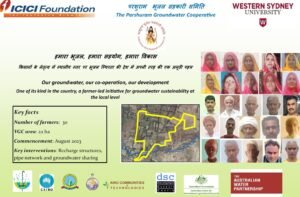Emerging from the MARVI initiative, Village Groundwater Cooperatives (VGCs) offer a promising institutional mechanism for community-led groundwater governance. These cooperatives bring together farmers and local stakeholders to share groundwater information, plan water-saving measures, and collectively recharge and manage their aquifer. The concept builds on the participatory ethos of MARVI and adapts Australia’s rich experience with cooperative groundwater management frameworks to suit Indian village contexts.
Piloted in selected villages in Rajasthan and Gujarat, VGCs are designed to be inclusive, democratic, and data driven. VGC members meet regularly to review rainfall and groundwater trends, supported by the information generated by Bhujal Jaankaars and the MyWell app. These meetings serve as forums for discussing seasonal cropping decisions, organising recharge activities, and addressing local water-sharing conflicts. Importantly, women are actively involved in many of these cooperative operations, contributing to gender equity in water governance.
The VGC model fosters a sense of ownership over groundwater as a shared resource, rather than a private commodity. This has helped sharing of groundwater among themselves, increased groundwater recharge, and promoted more sustainable farming practices. VGCs also serve as a platform for dialogue between villagers and externals, such as NGOs, researchers, and government agencies.
Supported by the Australian Water Partnership and Australian Centre for International Agricultural Research and implemented in partnership with the ICICI Foundation, local NGOs and Panchayats, VGCs are now being recognised as a potential institutional innovation that can be scaled across other parts of India. They illustrate how sustained engagement, local empowerment, and Australian cooperation can generate lasting solutions to complex water challenges.
The Village Groundwater Cooperative in Rajasthan – the implementation of the VGC led to significant increases in wheat production this year. Normally they harvest 15,000 kg from the VGC area and this year they have harvested close to 70,000 kg due to fencing of the area to protect the crop from ‘blue bull’, access to more groundwater and improved seed varieties.


